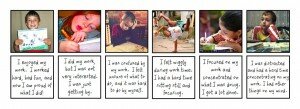
I have had this post swimming around in my head for a long time. For me, it was just a matter of how to present it. I hope this works…
Why We Need A Change
I think we owe our children better “behavior management systems.” I will be sharing a plan with you in this post that I hope fits the bill. The systems most commonly used today – color cards, stop lights, clip charts, reward boxes, sticker systems – give the job of managing behavior to the teacher. The child is the recipient of judgment. The judgment may be positive or negative, spoken or unspoken.
These systems do help children know and learn what is expected of them. However, they fail in helping children actually learn to manage themselves and their feelings, and they fail to help children become aware of themselves until after their behavior has been judged. I want to change that. I believe our children deserve to have us change that.
I have read several very powerful posts and articles that reinforce my beliefs that these systems need to be revamped. They each offer their own perspective, and I think it is very valuable to read their thoughts to get a rounded understanding of where I am coming from.
- Check out Nikki’s thoughts from Teaching in Progress to read about one teacher’s journey away from the clip chart system.
- Natalie from Chicken Blog gives a parent’s perspective on what behavior charts are really looking for from students.
- And Muriel’s blog The Positive Classroom is a wealth of information about positive methods for building and maintaining a classroom community. It is hard to choose just one article to refer you to, as all of her work is so relevant to this conversation. Have a look at her discussion of teaching children to focus as a start.
- These great articles, in addition to reading Becky Bailey’s work Conscious Discipline and Peter Johnston’s Choice Words, have affirmed my beliefs.
I have been working as well to come to some solutions for a better system, and have written about a few. However, I was not satisfied with my own solutions, so I kept digging.
A Solution
I am ready to offer up something that, while it is certainly not enough on its own, I believe to be a positive and effective alternative to the traditional clip chart system.
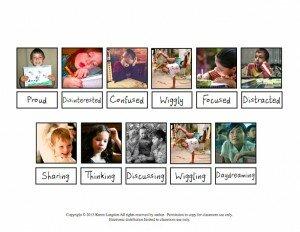
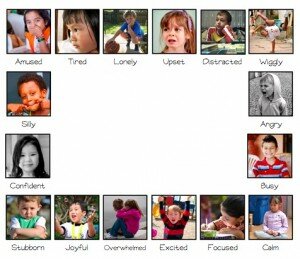
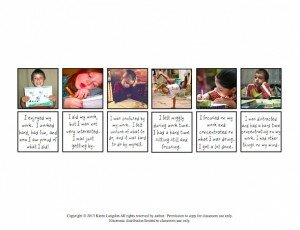
How This Clip Chart Works
This clip chart is NOT a chart where the teacher tells a child when and where to move the clip. Instead, each child has their own chart, and each child moves their own clips. The purposes of the chart are self-reflection and goal setting.
In the beginning there should be lots of discussion about the images on the chart. It is important that the kids understand that ALL of the pictures are normal and acceptable feelings, and that ALL people experience ALL of those feelings at different times. It is critical to normalize these feelings so that the kids don’t feel that there are “right” or “wrong” things to clip, or that anything is deemed to be “good” or “bad.”
Another key feature of my “system” is that the teacher also has his or her own clip chart. In this way, the teacher can model the thinking that goes into self-reflection, and help the kids to understand what it looks like to make goals about your learning. Here is my chart, which I keep up on my white board:
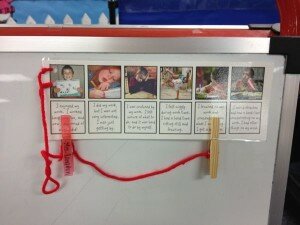
It is important to know that I am not always focused and on task in the classroom. One day after reading workshop I explained to my kids that I was distracted (and clipped my brown clip there.) I told them that I had a headache, and it was hard for me to concentrate. I also explained that my goal at that point was to be more focused. I did not expect to be able to get to the proud and joyful level that afternoon – that would be asking too much. So I set a more realistic goal. Observing these real feelings is important for kids. They have to understand that they are not bad, and that everyone goes through them.
After the chart is introduced, I like the first few “clips” to be done large group. I use my SMARTboard to project the file, so the kids can all easily see the options. I explain where on the chart I think I was during a certain activity period, as well as my goal for the next activity. The goal component is critical. Each child will actually have two clips – one for their reality, and one for their goal (I use plain clips for the reality clips, and decorative clips for their goals.). I then give them a minute to self-reflect and consider where they were in their learning during that activity period, as well as their personal goal. After they have those thoughts stored mentally, I send them to their desks to move their clips.
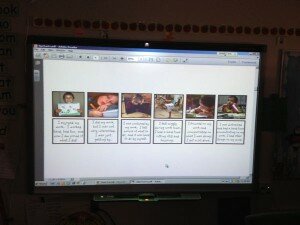
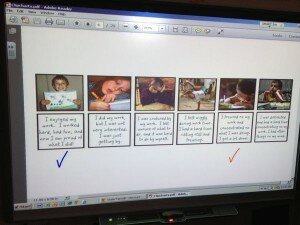
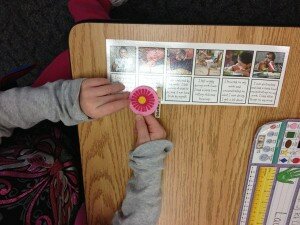
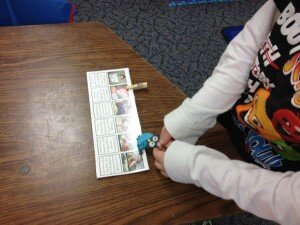
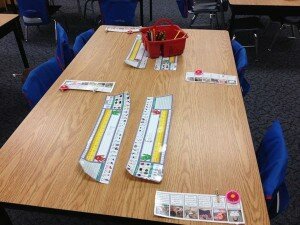
There should not be discussion encouraged among the students (or shut down.) Some kids will want to be more private about their choices, and some kids will want to share their goals. Either is fine, as long as the kids know that they are never to move someone else’s clip.
I encourage my students NOT to move their clips at random times, at least at the beginning. We have planned times throughout the day for reflection. This will do two things – it will help the kids to take the system seriously and honestly reflect on their feelings and their learning. It will also give the teacher an opportunity to take note of how kids are self- assessing.
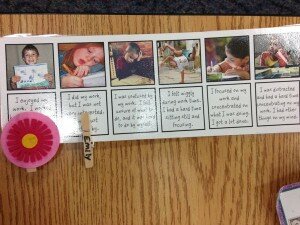
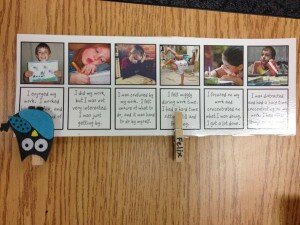
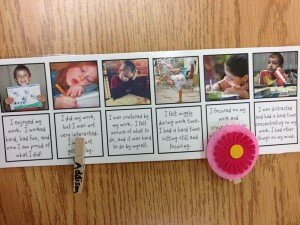
Tracking Student Responses
I also created some data tracking forms to be used as a resource to use if you have certain students whose learning behaviors you want to track, or if you are looking for class information about certain activity periods in the day. You can keep track of how a student self-reports their feelings every day during writing, for example, and you can compare their reflection to how you, as the teacher, interpreted their actions. This system will easily provide lots of insight into what may or may not be impacting student learning, motivation, and behavior.
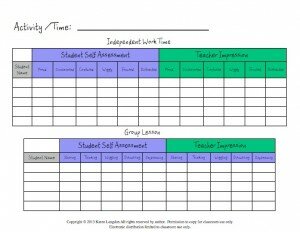
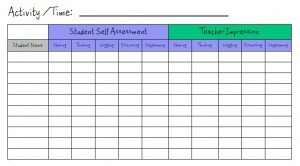
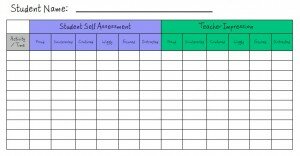
My hope is that this type of “behavior management” shifts the job of managing to the students. They will begin to learn how to recognize their feelings and learning behaviors, and they will learn to set goals for themselves as learners.
I may still have students demonstrating “negative” behaviors for some time. However, my goal is to build in them the capacity to be self-aware, and after time, become aware of how they impact others.
Get the Charts For Yourself!
My set of charts is available in my store. Have a look if you are moved to do so.
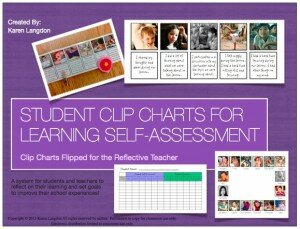
Please give your thoughts and feedback. And please consider sharing this link with friends and colleagues if you are like minded. Let’s make a change for our kids – a change they deserve.

Thanks for sharing this! I’m curious about a few things. If you have a child who is off task how do you manag
whoops! Hit send too soon! How do you manage adisruption? Do you ask them to have some reflection time? Also how do you communicate behavior to parents? Parents are so used to the color changes :)Do you do any kind of reward system at all?I really love this system and plan on purchasing on tpt. We have too many kids who do not know how to self regulate and I think this is a great concept if implemented correctly.
Hi! Thanks so much for asking!
1. When redirecting disruptive behaviors, I have to consider the situation. If a child is wiggling and not focusing during a work time, I may have them look at their chart and consider if they think their behavior is helping them to achieve their goal. If not, then we can work together to come up with an idea of how to redirect what they are doing so it DOES help them reach their goal. Of course, some behaviors are different than others – if a child is not being safe, or is being hurtful to others, I would focusing on helping them calm down and become safe. It is important that this clip chart is NOT intended to be used as a DIRECT behavior management system. What I mean is, the teacher should not be telling kids where they are on the chart, or where they should be. However, having them reflect and make goals will lead them in a positive direction.
2. I do not communicate behavior to parents on a daily basis. I think that that much communication is actually too much, and not very clear. For example, our school day has approximately 400 minutes in it. That means that are about 400 opportunities for different behaviors. I find that one color card may communicate how a day ENDED, but it does not give any information as to the many other moments throughout the day. And with lots of kids, once they move a card, they may shut down and give up on those other minutes. So, with parents, I tend to contact them when I am seeing patterns of negative behaviors over time, or there is something particularly serious (a punch, pulling down pants, etc.) The advantage of this system is that I can gather some meaningful information to share with parents. For example, if I use the data tracking forms, I might learn that a particular student consistently rates their feeling as “distracted” during independent writing time, and I might notice that this is a time when we have behavior issues. I can then talk with parents about this, and suggest some ideas to help their child focus during writing. This communication is much more powerful and specific, so parents are receptive.
3.I do not use rewards at all. For me, rewards are the the other end of punishment. Both rewards and punishments actually trigger activity in different areas of the brain than what I am looking for. Punishment sends kids into fight or flight in the hindbrain. Rewards send kids into the addictive centers in the brain. Kids can become addicted to rewards, praise, etc. However, when they are experiencing learning and are in a “play state” (that place where you are so engaged and curious that you lose track of time) they are actually in a very different part of the brain. They are building internal motivation, and the BRAIN is rewarding them through endorphins and dopamine. I also hesitate to use rewards because I want kids to do the right thing BECAUSE it is the right thing, not in order to get a reward.
A few years ago, as part of my writing celebrations, I used to get cookies and punch for my kids to celebrate. I quickly realized that this was completely unnecessary. The kids were happy enough to eat, but what they were really excited for was to share their work with others. I want to cultivate that real, intrinsic motivation, as well as pride (self-assessed) in something well done.
I know that may be more than you were looking for, but I really think that your questions were incredibly important, and I wanted to be as clear as possible. Please let me know if you have any other thoughts or questions, and also let me know how it goes in your classroom!
I like this idea. Kids need visual reminders, and your chart does just that. How would you use this with many classes? Our school is departmentalized, and teachers have different classes throughout the day… I agree with you about rewards. I try not to do rewards now after my brother, a store manager, has had trouble with young employees who want to be rewarded to work. (Guess a paycheck isn’t motivation enough.) I think young people have learned that they deserve a reward every time they do something, not just that it’s the right thing to do… How do you handle disruptive behavior, students who cause disruptions and who are rude
I think with multiple classes you have a couple of options. One would be to not give the kids their own charts. You could just project (or use a poster board for that matter) one large chart, model where you would mark yourself, and have them think about where they would place themselves (and set their goals.) This removes the benefit of being able to see what each child selects individually, but it does teach the kids the same values and thinking processes.
Another option would be to have folders for each student in a file. Perhaps each class has one magazine file full of their folders, or something like that, and there charts are inside. You could laminate the charts and have the kids mark the spots using dry erase markers instead of clips (one color for self-reflection, one for goal). Then they would not take as much space.
If you read through the other comments, you will find lots of thoughts on managing the disruptive behaviors.
THANK YOU for finally articulating all of my thoughts! I have tried to explain this to others and I always get a puzzled look, when they realize there is no bribing involved! I attended a Conscious Discipline workshop about 3 years ago that changed my life! I am definitely going to try this with my kindergarten class this year!
So glad you found it helpful. Conscious Discipline changed my life as well, and I continue to work on finding my balance of how to manage things in my room. I think the more credit we can give kids, the better. They want to learn, do well, and be appreciated – naturally. We don’t need to pay them for that (or bribe). We just need to teach them how to achieve it.
Hi,
Sounds great, you think this will work for Pre-K? Any adaptations you may suggest? I might have to tape the chart on their cubby, since they have no desks.
Thanks!
Do you have any academic evidence to back up your arguments against traditional behaviour mnagement strategies? So far, all your posts tend to read a bit like;
“I dislike this idea. My idea is better. Here is my idea”
You cite blogs for “further reading” but, from a critical standpoint, you don’t actually supplement your arguments with sufficient, credible evidence.
I see how you have implemented the personal clip charts on their desks, but how do you use the emotions clip chart?
Thank you for these tools! I love it!
Hi Alexa! I use the emotions clipcharts with specific students that have a difficult time identifying their emotions. Some kids experience feelings in black and white – fine and ANGRY! What they don’t realize is that they might not be angry. They might be tired, overwhelmed, jealous, etc. The emotions chart helps them to learn to recognize and label more complex emotions.
Would you mind posting your schedule so other teachers have in mind on how much your school is required to instruct?
How would you comment on kids understanding rewards and punishments as they grow older, because they most certainly will become a huge part of their lives when maturing?